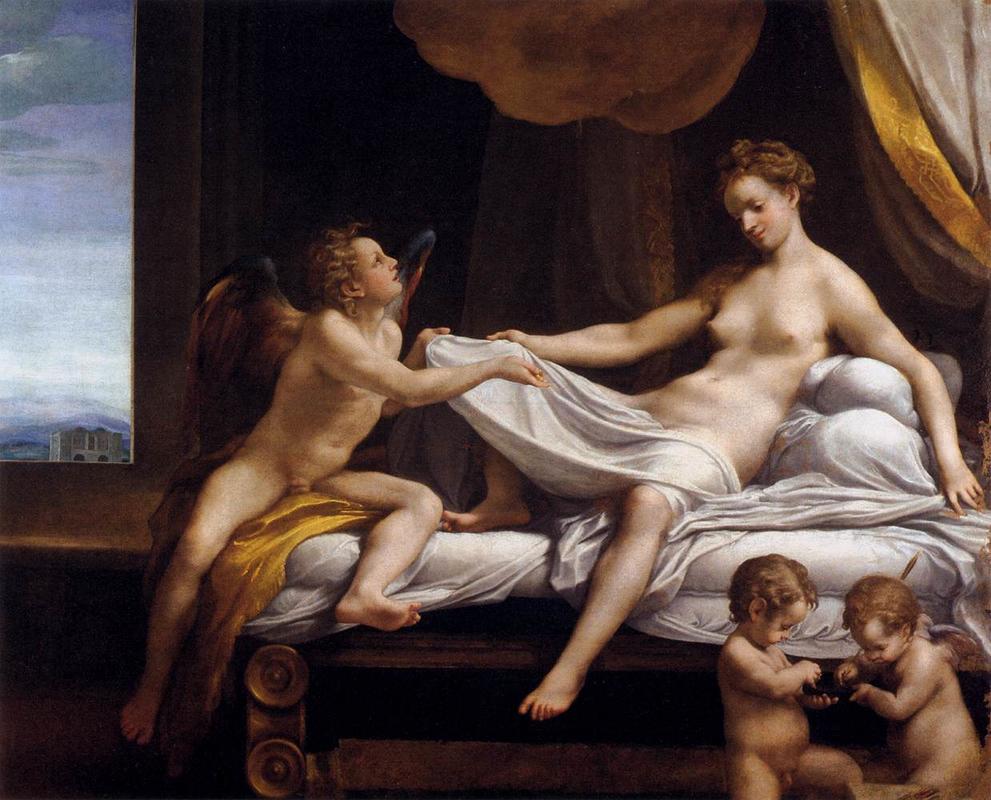More about Danaë

Contributor
Danaë was the favorite Correggio painting of Titian, who loved Correggio's work in general.
In fact, the "pose and composition" of Titian's Venus of Urbino was borrowed from this Danaë. Iwan Lermolieff, a pseudonym of the 19th century Italian art critic Giovanni Morelli, agreed with Vasari that this is a great representation of Correggio's work, especially his command of color, and wrote that, even though it's probably not suitable for hanging "in a girl's school," it is "chaste, in the true sense of the word," distinguishing it from the "immodest prudery of the present time." By "immodest prudery," Lermolieff was joking about the fertile ground for the budding industry of psychiatry and the Victorian-era preoccupation with censorship as an attempt to enforce modesty and ethical wellbeing. Like most art historians, he lamented the significant changes in the production of art since ancient times, claiming that this work merited a place, more than any other recent one, with the artworks of the ancient Greeks and Romans. Understandably, Vasari mistakes this image for a picture of Venus. The provenance of this work is full of sovereigns, including royal names of Prague, Stockholm, and London.
Ovid's "Metamorphoses" is the source of the subject matter of this work and three other Correggio Loves of Jupiter, commissioned by Federico II Gonzaga, 5th Marchese of Mantua. In it, Danaë is the daughter of King Acrisius of Argos. As in Oedipus Rex, the oracle at Delphi gives the king a prophecy of family betrayal that would be a bummer for anyone, indicating that Acrisius will be toppled by his grandson Perseus, son of Danaë. Like any tragic hero, Acrisius figures that the prophecy is wrong, but not wrong enough to ignore it. If he ignored the oracle's words, the story wouldn't work at all: he acknowledges them, but assumes that his material wealth and temporal power can overrule them. Thus, the story functions to confirm, against all appearances, the infallibility of prophecies and intuitions. "You're grounded, young lady!" says the king, and Danaë finds herself restricted to a tower, like Rapunzel, which happens to be made of bronze. Danaë appreciates the avant-garde nature of her new house, and the fact that she has room service and pays no rent, but the all-powerful deity Jupiter, also known as Jove and Zeus, who governs money and precious objects in Western astrology, decides that the prophecy must be fulfilled, and appears to her as "golden rain," which mystically impregnates her with Perseus.
Sources
- Brinton, Selwyn. Correggio. London: Bell, 1907.
- Gould, Cecil Hilton Monk. The Paintings of Correggio. Ithaca, NY: Cornell University Press, 1976.
- Heaton, Mary Margaret. Antonio Allegri Da Correggio from the German of Dr. Julius Meyer. New York: MacMillan, 1876.
- Mansfield, Elizabeth. Art History and Its Institutions: The Nineteenth Century. London: Routledge, 2005.
- Ricci, Corrado. Correggio: With 296 Reproductions in Collotype. London: F. Warne & Company, Limited, 1930.
- Salvo, Mario. "'Danae'. Opera di Antonio Allegri detto il Correggio." Aletes, Oct. 10, 2018, http://www.aletes.it/danae-opera-antonio-allegri-detto-correggio/.
- Sluijter, Eric Jan. Rembrandt and the Female Nude. Amsterdam: Amsterdam University Press, 2006.
Featured Content
Here is what Wikipedia says about Danaë (Correggio)
Danaë is a painting by the Italian Renaissance artist Correggio, executed around 1531 and now in the Galleria Borghese in Rome.
Check out the full Wikipedia article about Danaë (Correggio)












